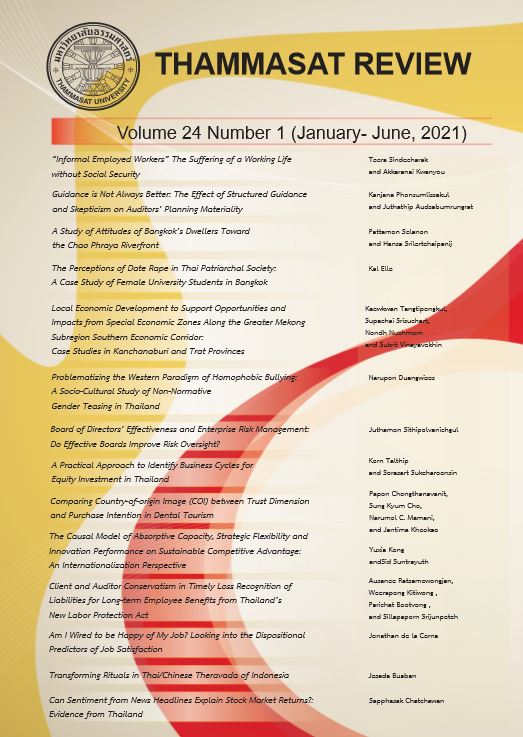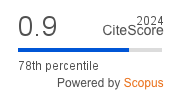Can Sentiment from News Headlines Explain Stock Market Returns?: Evidence from Thailand
Keywords:
News-based sentiment index, Stock markets, Textual analysisAbstract
The objective of this study was to investigate whether sentiment from financial market headline news explains equity returns. Techniques from computational linguistics were employed to extract the news-based sentiment from a corpus of financial market headlines collected from a newsfeed of a financial newswire.
In this study, news sentiment was classified as the overall sentiment and included both the positive and the negative sentiment. Using daily financial market data from 2017-2019, the overall sentiment and the positive sentiment were found to explain the equity returns of the Stock Exchange of Thailand (SET) while the negative sentiment did not explain the returns.
References
Atkins A., Niranjan, M., & Gerding, E. (2018). Financial news predicts stock market volatility better than close price. The Journal of Finance and Data Science, 4(2),120-137. doi.org/10.1016/j.jfds.2018.02.002
Boudoukh, F., Feldman, R. Kogan, S., & Richardson, M. (2012). Which news moves stock
prices? a textual analysis (NBER working paper No. 18725). Retrieved from National Bureau of Economic Research website: https://www.nber.org/papers/w18725
Ferguson, N.J., Philip, D., Lam H.Y.T., & Guo, M. (2015). Media content and stock returns: the predictive power of press, Multinational Finance Journal, 19(1), 1-31. doi.org/10.1080/15427560.2020.1772261
Garcia, D. (2013). Sentiment during recessions. The Journal of Finance. 68(3), 1267-1300. doi.org/10.1111/jofi.12027
Gotthelf, N., & Uhl, M.W. (2018). News sentiment - a new yield curve factor. Journal of Behavioral Finance, 19 (3),31-41. doi.org/10.1080/15427560.2018.1432620
Heston, S. L., & Sinha, N.R. (2017). News versus sentiment: predicting stock returns from news stories, Financial Analysts Journal, 73(3),67-83. doi.org/10.2469/faj.v73.n3.3
Lamoureux, C., & Lastrapes, W. (1990). Heteroskedasticity in stock return data: volume versus GARCH effects. The Journal of Finance, 45(1), 221-229. doi:10.2307/2328817
Loughran, T., & McDonald B. (2011). When is a liability not a liability? textual analysis, dictionaries, and 10-Ks. The Journal of Finance, 66(1), 35–65. doi.org/10.1111/j.1540-6261.2010.01625.x
McLaren, N., & Shanbhogue, R. (2011). Using internet search data as economic indicators (Bank of England Quarterly Bulletin No. 2011 Q2). Retrieved from National Bureau of Economic Research website: https://www.bankofengland.co.uk/quarterly-bulletin/2011/q2/using-internet-search-data-as-economic-indicators
Nelson, D., B. (1991). Conditional heteroskedasticity in asset returns: a new approach. Econometrica: Journal of the Econometric Society, 59(2),347-370. doi.org/0012-9682(199103)59:2<347:CHIARA>2.0.CO;2-V
Tetlock, P. (2007). Giving content to investor sentiment: the role of media in the stock market. Journal of Finance, 62(3), 1139–1168. doi.org/10.1111/j.1540-6261.2007.01232.x
Tetlock, P., Saar-Tsechansky M., & Macskassy S. (2008). More than words: quantifying language to measure firms’ fundamentals. Journal of Finance, 63(3), 1437–1467.doi.org/10.1111/j.1540-6261.2008.01362.x
Uhl, M.W. (2014). Reuters sentiment and stock returns, Journal of Behavioral Finance, 15(4), 287-298. doi.org/10.1080/15427560.2014.967852
Uhl, M.W. (2017). Emotions matter: sentiment and momentum in foreign exchange, Journal of Behavioral Finance, 18 (3),249-257. doi.org/10.1080/15427560.2017.1332061
Downloads
Published
How to Cite
Issue
Section
License
The opinions and ideas expressed in all submissions published in Thammasat Review are solely that of the author(s) and do not necessarily reflect that of the editors or the editorial board.
The copyright of all articles including all written content and illustrations belong to Thammasat Review. Any individuals or organisation wishing to publish, reproduce and distribute a particular manuscript must seek permission from the journal first.








